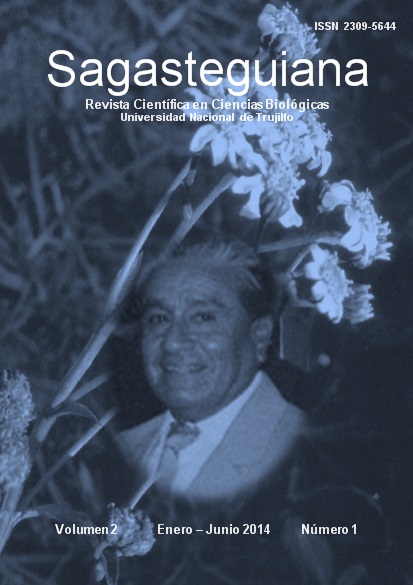EFECTO DE TRES CONCENTRACIONES DE CO2, OBTENIDO DE VALVAS DE Argopecten purpuratus “CONCHA DE ABANICO”, EN EL CRECIMIENTO POBLACIONAL DE Tetraselmis suecica EN CONDICIONES DE LABORATORIO
Resumen
En el presente trabajo se evaluó el efecto de tres concentraciones del CO2 (1, 5 y 10 %) obtenido de valvas de Argopecten purpuratus “concha de abanico” en el crecimiento poblacional de Tetraselmis suecica en condiciones de laboratorio, utilizándose el diseño experimental completamente al azar. Todos los cultivos fueron fertilizados con el medio Guillard. Los resultados permiten establecer una relación directa entre la dosificación de CO2 y la disminución del pH y el mejor incremento de biomasa se obtuvo con el tratamiento al 10% de CO2, aunque sin mostrar diferencias estadísticas significativas con valores de 210, 220.23, 249 y 250 mg L-1 para los cultivos dosificados con 0, 1, 5 y 10 % de CO2, respectivamente. Las mayores dosificaciones de CO2, al parecer, no afectan la fisiología fotosintética e incrementan su disipación por desorción de los cultivos algales.
Palabras claves: Tetraselmis, CO2, crecimiento algal.
ABSTRACT
In this paper the effect of three concentrations of CO2 was evaluated (1, 5 and 10%) obtained from leaflets Argopecten purpuratus "scallops" on the population growth of Tetraselmis suecica in laboratory conditions, completely experimental design used to randomly. All cultures were fertilized with Guillard medium. The results indicate a direct relationship between the dosage of CO2 and decreasing pH and the best increase in biomass was obtained with treatment 10% of CO2, but not show statistically significant differences with values of 210, 220.23, 249 and 250 mg L-1 for crops dosed with 0, 1, 5 and 10% of CO2, respectively. The higher doses of CO2, apparently not affect the photosynthetic physiology and increase its dissipation by desorption of algal cultures.
Keywords: Tetraselmis, CO2, algae growth.
Citas
Acién G. 2007. Usos y Valorización del CO2. Dpto. Ingeniería Química, Universidad Almeria. Curso de Verano: Generación de Electricidad mediante Carbón – EL reto del CO2, Pp. 1-65. España.
Dauphin, Y.; N. Guzman; A. Denis; J. Cuif & L. Ortlieb. 2003. Microstructure, nanostructure and composition of the shell of Concholepas concholepas (Gastropoda, Muricidae). Aquatic Living Resources. Vol. 16, Number 2, Pp. 95-103.
Fábregas, J., E. Morales, J. Arán & A. Otero. 1995. Germinated Solanum tuberosum: An Agricultural Product for marine microalgae culture. Bioresource Technology. 66:19-24.
García, M. 2006. Regulación Redox de la Rubisco: Contribución estructural y funcional del par de residuos conservados Cys172 y Cys192. Departamento de Bioquímica I Biología Molecular. Universidad de Valencia. Pp. 1-224. España.
Guillard, R. 1975. Division rates. In: Handboock of phycological methods and growth measurement. J. R. Stein (ed). Cambridge University Press. London. 290-311 pp.
Gordillo, F. et al. 2003. Influence of elevated CO2 and nitrógeno suplíonthe carbon assimilation performance and cell composition of the unicellular alga Dunaliella viridis. Physiologia Plantarum 119:513-518..
Mercado, J. 1999. Fotosíntesis y cambios en la composición de la atmósfera. Ciencia al Día Internacional, Nro. 2, Vol. 2, ISSN 0717-3849.
Pulz, O. 2001. Photobioreactors: Production sistems for phototrophic microrganism. Appl. Microbiol. Biotechnol. 57:287-293.
Said, A. 2007. El Bióxido de Carbono y la vida. Biology Cabinet, Pp. 4.
Shiraiwa, Y.; A. Goyal & N. Tolbert. 1992. Alkalization of the Medium by Unicellular Green Algae during Uptake of dissolved Inorganic Carbon. Plant and Cell Physiology, Vol. 34, Issue 5, Pp. 649-657.
Sorokin, C. 1975. Dry weight, packed cell volume and optical density. 321-343 p. en Sein, J.R. (Ed). Handbook of phycological methods. Culture methods and growth measurements. Cambridge University Press. Cambridge. MA.USA. 448 pp.
Velea, S.; N. Dragos; S. Serban; L. Ilie; D. Stalpeanu; A. Nicoara & E. Stepan. 2009. Biological sequestration of carbon dioxide from Thermal power plant emissions, by absorbtion in Microalgal culture media. Romanian Biotechnological Letters Vol. 14, No. 4, 2009, pp. 4485-4500.
Yang, Y. & K. Gao. 2003. Effects of CO2 concentrations on the freshwater microalgae, Chlamydomonas reinhardtii, Chlorella pyrenoidosa and Scenedesmus obliquus (Chlorophyta). Journal of Applied Phycology. 0:1-11.
Descargas
Publicado
Cómo citar
Número
Sección
Licencia
LOS AUTORES CONSERVAN SUS DERECHOS:
- Los autores/as conservan sus derechos de marca y patente, y también sobre cualquier proceso o procedimiento descrito en el artículo.
- Los autores/as retienen el derecho de compartir, copiar, distribuir, ejecutar y comunicar públicamente el artículo publicado en la revista Sagasteguiana (Ejemplo: colocarlo en un repositorio institucional o publicarlo en un libro), siempre que se indique la publicación inicial en esta revista.
- Los autores/as conservan el derecho a hacer una posterior publicación de su trabajo, de utilizar el artículo o cualquier parte de aquel (Ejemplo: compilación de sus trabajos, notas para conferencias, tesis, o para un libro), siempre que indiquen su publicación inicial en Sagasteguiana (autores del trabajo, revista, volumen, número y fecha).



